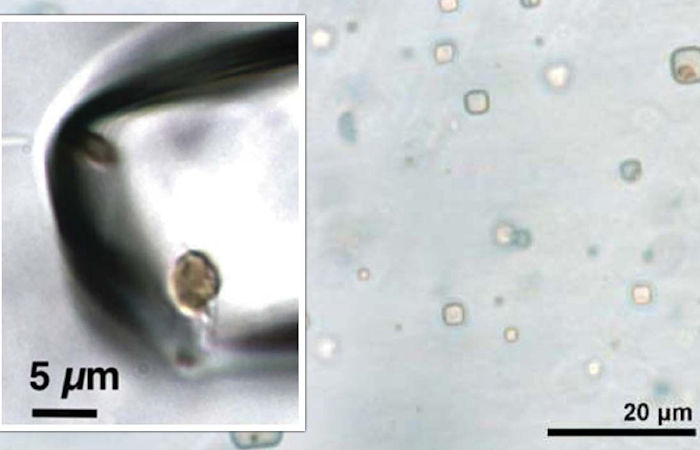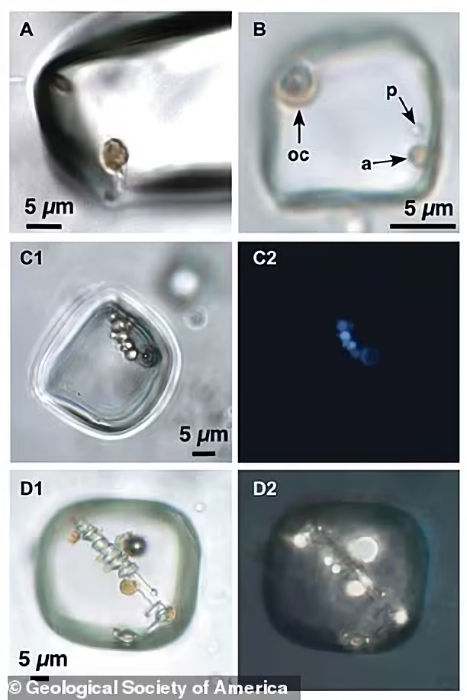Conny Waters - AncientPages.com - Scientists are curious and want to open an 830-million-year-old rock crystal that contains ancient microorganisms that may still be alive. To some, this sounds like the opening of Pandora's box and there is no lack of criticism. Should researchers proceed or leave the rock salt crystal in peace?
Earlier this month, researchers from the Geological Society of America first announced their discovery of tiny remnants of prokaryotic and algal life inside an ancient halite crystal.
Drops of fluid preserved within rock salt that formed 830 million years ago contain microorganisms. Credit: Schreder-Gomes et al. / Geology
These organisms were found inside microscopic bubbles of liquid in the crystal, known as fluid inclusions, which could serve as microhabitats for the tiny colonies to thrive. Currently, it is unknown whether these ancient organisms are still alive or not, and this is what scientists want to open the crystal - to find out if ancient life is truly still alive.
'There are little cubes of the original liquid from which that salt grew. And the surprise for us is that we also saw shapes that are consistent with what we would expect from microorganisms. And they could be still surviving within that 830-million-year-old preserved microhabitat.
It does sound like a really bad B-movie, but there is a lot of detailed work that's been going on for years to try to figure out how to do that in the safest possible way,' study author Kathy Benison, a geologist at West Virginia University told NPR.
The extraordinary discovery was initially reported in the journal Geology on May 11.
"The researchers used a selection of imaging techniques to study fluid inclusions in a chunk of halite from the 830-million-year-old Browne Formation in central Australia.
They discovered organic solids and liquids that were consistent in size, shape, and fluorescent response to cells of prokaryotes and algae.
The discovery shows that microorganisms can remain well preserved in halite over hundreds of millions of years.
This has implications for the search for alien life, according to the researchers.
It is possible that similar biosignatures could be detected in chemical sediments from Mars, where large salt deposits have been identified as evidence of ancient liquid-water reservoirs," the Daily Mail reports.
To many ordinary people bringing 830-million-year-old life forms back into the modern world sounds like the beginning of an apocalypse, but many scientists agree with Benison explaining that "if carried out cautiously and correctly, the feat should not be a concern. After all, an organism that is hundreds of years of millions of years older than humans is unlikely to be well-adapted to infect us or bring harm.," the IFL Science reports.
"An environmental organism that has never seen a human is not going to have the mechanism to get inside of us and cause disease. So I personally, from a science perspective, have no fear of that," commented Bonnie Baxter, a biologist at Westminster College in Salt Lake City, who was not involved in the study.
While it may sound implausible that the microorganisms inside the crystal could still be alive, living prokaryotes have previously been extracted from halite dating back 250 million years, so it is not impossible they could survive 830 million years.
"Possible survival of microorganisms over geologic time scales is not fully understood,' the researchers wrote in their study.
It has been suggested that radiation would destroy organic matter over long time periods, yet Nicastro et al. (2002) found that buried 250 million-year-old halite was exposed to only negligible amounts of radiation.
Additionally, microorganisms may survive in fluid inclusions by metabolic changes, including starvation survival and cyst stages, and coexistence with organic compounds or dead cells that could serve as nutrient sources."
The study was published in the journal Geology
Written by Conny Waters - AncientPages.com Staff Writer







